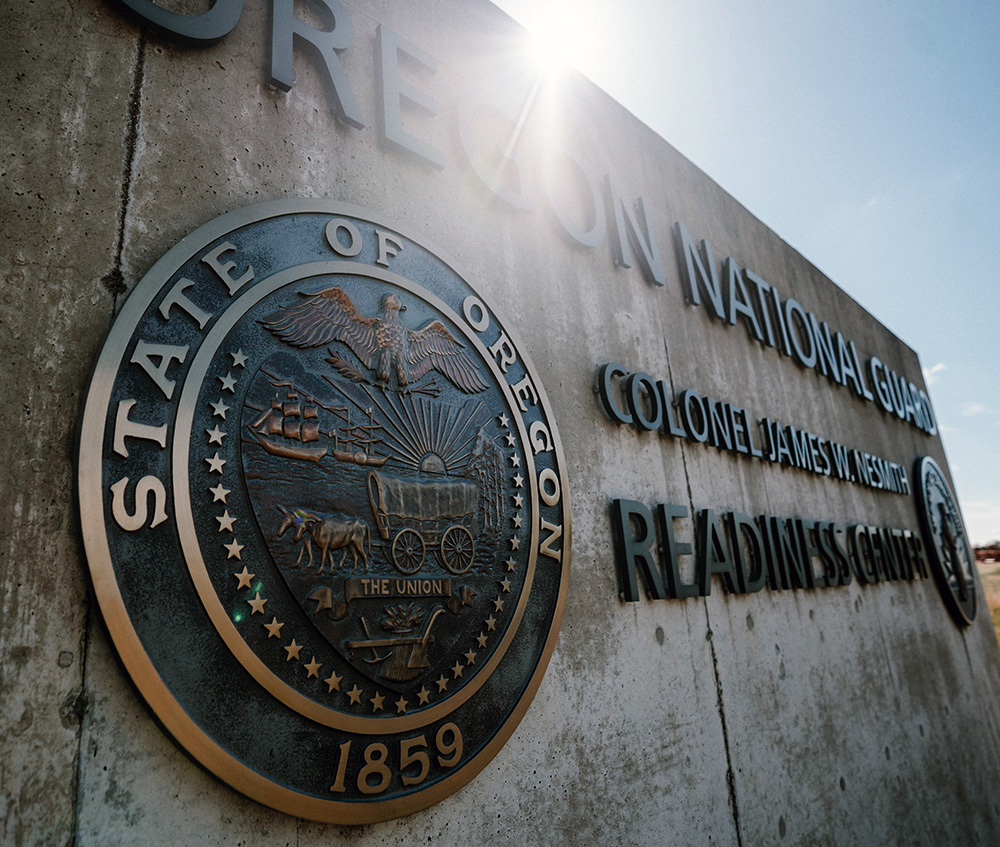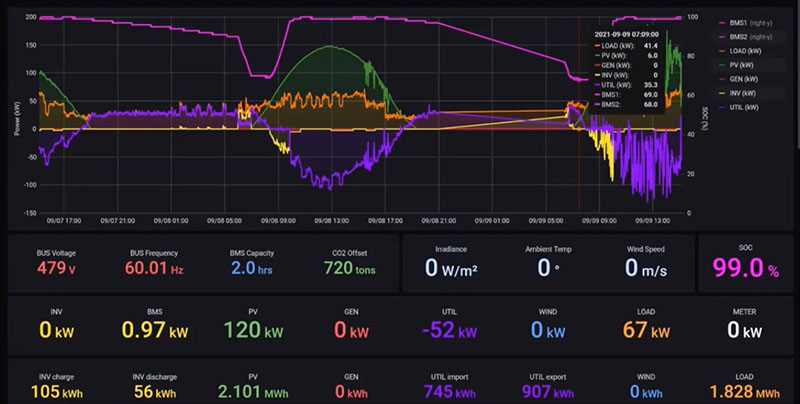The Oregon National Guard is preparing for a major earthquake and tsunami expected to strike the Pacific Northwest within the next 50 years. One effort is to make essential National Guard facilities more power resilient, so they can provide services to the population for two weeks after the event when grid electricity and other amenities are likely to be disrupted. We bring you the story of the feasibility analysis and design of a National Guard microgrid in Dallas, Oregon. Commissioned in 2021, the facility could serve as a model for more upgrades across the state.
Many aren’t aware of the impending danger of an earthquake happening off the northern Pacific coastline of the United States (U.S.). But scientists predict a one-in-three chance that, within the next 50 years, a major earthquake with a potential 7.0 to 9.0 magnitude range is likely to strike the Pacific Northwest. The source will be the Cascadia subduction zone, a “megathrust” fault running approximately 700 miles from northern California, along the coast of Oregon and Washington, and up north to Vancouver Island in British Columbia.
Two giant tectonic plates, one under the continent of North America and another smaller plate to the west in the Pacific Ocean, are pushing together and creating mounting pressure. When the fault ruptures, it’s likely to generate a massive earthquake.
Geologists have confirmed the Cascadia subduction zone — located from 50 to 100 miles offshore — ruptures roughly every 250-300 years. Every 500 years, one of those earthquakes is a “monster” with a magnitude of 9.0. It has been slightly over 300 years since a 9.0 magnitude earthquake struck in 1700, sending tsunami waves eastward to flood the Pacific Northwest coastline and westward, hitting Japan about ten hours later. Should a similar event occur, the Oregon Health Authority reports that fatalities from the tsunami in Oregon alone could approach 20,000 — and that doesn’t include earthquake-related casualties.
Earthquake readiness in the Pacific Northwest
Faced with the prospect of such a potentially catastrophic event, local governments in the U.S. Pacific Northwest and Canada have been taking steps to prepare. Five years ago, the Oregon Seismic Safety Policy Advisory Commission (OSSPAC), also known as “the earthquake commission,” determined the state was not ready for a major earthquake and resulting tsunami and outlined plans to improve preparedness.
OSSPAC believes a constructive pre-emptive strategy should include improving the earthquake resistance and electrical power resiliency of critical buildings — particularly hospitals, schools and other essential facilities that could serve as shelters or emergency command centers.
The Oregon National Guard is on the front line

One essential facility is the Oregon Military Department’s (OMD) Colonel James Nesmith Readiness Center — the National Guard’s new term for an armory. Located southwest of Portland in Dallas, Oregon, the 40,000-square-foot building serves as a National Guard training center for the Air National Guard and a rural center for community events. Designed to be “welcoming and secure,” the award-winning center looks like a large barn amid the lush green Willamette Valley.
In an emergency, the Nesmith Center could be a staging area for the Red Cross or a command center for rescue operations.
“I’ve long been a champion of creating islanded systems that could operate when the grid is down,” National Guard Senior Construction Manager Eric Manus said. He explained that Nesmith already had a solar photovoltaic (PV) array, but it would have been inoperable during a grid outage. OMD sought to add an energy storage system that would enable operation even when the grid was down for an extended period. Manus noted that getting Nesmith closer to net-zero carbon emissions was another objective of the system.
“Now, we have a microgrid with energy storage and backup generators, and the data from operating it for over a year. We know exactly what it requires and what it costs to take a facility that can operate critical loads for 72 hours and extend that to 14 days, so this project can be a model for other buildings.” Should an emergency event take place, we would be able to shelter the community and provide crucial services,” Manus said.
Three-year design project begins with a feasibility study

In 2018, Sunlight Solar, the renewable energy contractor on the project, chose Mayfield Renewables to conduct a feasibility study and design a microgrid that would improve resiliency at the Nesmith Readiness Center. Oregon’s emergency response authorities estimate that tens of thousands of citizens could be without vital services and assistance for two weeks after the earthquake. One essential requirement was for Mayfield Renewables to make powering Nesmith’s critical loads self-sufficient for that duration.
When the project began, the Nesmith Readiness Center had an existing 255-kilowatt (kW) solar photovoltaic array and a 150-kW diesel generator. The feasibility analysis results determined that adding the energy storage system (ESS) would allow the National Guard to use the existing solar assets and provide backup power for 14 days.
Retrofitting existing hybrid power systems presents a challenge
Only a few years ago, the National Guard emergency plan was to run the site with a diesel generator, using an onsite 1,000-gallon fuel tank. But 1,000 gallons wasn’t enough fuel to enable operation for two weeks. Plus, fuel delivery would likely be difficult or impossible in the wake of a significant earthquake or tsunami.
Using HOMER® Grid software, Mayfield Renewables determined the technical feasibility of a solar-plus-storage system with diesel backup that would provide power for two weeks during an emergency that caused loss of the power grid. By modeling the design, the engineering firm also showed that the National Guard facility would save money during normal operations. Since the system has been commissioned, that analysis has been borne out by lower utility bills.
But accurate energy modeling requires accurate electrical load or energy use data. So first, Mayfield Renewables used eGauge meters and electrical current transformers to get estimates of the site’s load requirements for several months. Then the company created nine different HOMER Grid models for the Nesmith Center. It compared the performance of different energy storage systems at various times of the year, according to Justine Sanchez, then Mayfield Renewables program director for solar-plus-storage. The selected system was a lithium ferrous phosphate battery made by Blue Planet Energy, partially because they were able to install these batteries indoors — another National Guard requirement — and because it poses a lower risk of thermal runaway. The Blue Planet Energy system also was big enough to handle power from the entire 255-kW PV array.
Sanchez said one challenging issue that added complexity was integrating new energy storage with the existing generator system and making sure it was code compliant. She said that Mayfield’s experience in electrical code was critical in finding the solution. Ultimately, the final design had to delink the emergency generator panel from the solar and storage. Sanchez said it took eight months to design the upgraded system and three months each to get approval from the Authority Having Jurisdiction (AHJ) and the utility, respectively.
Upgraded National Guard facility combines power resilience and cost savings

After commissioning in the spring of 2021, the new microgrid at the Nesmith Readiness Center operates successfully, providing modest savings in demand charges and improving its resiliency.
“This project was a great learning experience, and we have the opportunity to replicate what we’ve learned at other sites,” said Ryan Mayfield, chief executive officer (CEO) of Mayfield Renewables. With the risk posed by a Cascadia earthquake and tsunami, Pacific Northwest jurisdictions and the National Guard’s other 40 readiness centers are taking measures to prepare. The Nesmith Center could serve as a valuable blueprint.

UL Solutions HOMER Grid is a market-leading solar-plus-storage software tool for designing grid-tied distributed energy systems. With an integrated utility tariff database and a new module for electric vehicle charging stations, it optimizes peak shaving to help commercial and industrial utility customers lower their demand charges. HOMER Grid can model projects with wind and combined heat and power as well as islanded systems, helping users improve their resiliency. Explore your opportunities with HOMER Grid during a complimentary trial. Learn more and download your complimentary trial.
More information about the Cascadia Earthquake
What is the Cascadia Subduction Zone?
The San Juan de Fuca tectonic plate, at the northeastern edge of the Pacific Ocean, is pushing east under its larger neighbor, the North American plate, upon which our entire continent sits. Where these two plates meet creates the Cascadia subduction zone.
History
The existence of the Cascadia “megathrust fault” and its implications was confirmed through a series of discoveries by scientists in the 1980s and l990s. Geologists had suspected its existence in the late 1960s when they first developed the theory of plate tectonics. The fault lies at the edge of the Pacific Ocean on the “Ring of Fire,” which has been producing the world’s most powerful earthquakes and volcanoes throughout recorded human history. Geological research, Japanese historical records, Native American oral history and sediment samples of the sea floor helped scientists reconstruct a precise record of past earthquakes in the Pacific Northwest.
More recently, details on the Cascadia subduction zone have emerged with concerning clarity. The likelihood of an imminent monster earthquake in the region was confirmed in the late 1980s when scientists from the U.S. Geological Survey discovered a “ghost forest” of dead red cedar trees near the Washington coast and wondered what had killed them. Carbon dating and tree ring analysis revealed that saltwater drowned the forest sometime in the early 1700s when the coast subsided in an earthquake. That event was confirmed by historical Japanese records, including written documentation dating from 599 AD.
The Cascadia earthquake and tsunami: How big could they be?
Geologists can estimate an earthquake’s magnitude based on the fault’s length; if the entire Cascadia subduction zone ruptures at once, it could produce a magnitude 9.0 earthquake. The odds of this happening are one in ten. Magnitude 9.0 earthquakes are rare; there have only been five since 1900, including the 2011 earthquake that caused the Fukushima nuclear disaster at the Fukushima Daiichi Nuclear Power Plant in Japan.
If a smaller section of the fault ruptures, it’s more likely to range from magnitude 8.0 to 8.6, still a monster earthquake. The odds of that happening in the next 50 years are one in three.
Because the fault lies between 50 and 100 miles offshore, a Cascadia megathrust earthquake would, if history indicates, generate a giant tsunami, predicted to arrive ashore in the U.S. about fifteen minutes after the earthquake occurs. The Oregon Department of Emergency Management estimates the tsunami could be 100 feet high. The department also believes that the tsunami alone could be responsible for almost 20,000 fatalities, depending on the time of year the earthquake strikes. The worst scenario would be during the busy summer tourist season. The earthquake itself would result in additional casualties, with estimates varying widely.
